Financial Reporting: Accounting Standards Homework Assignment
VerifiedAdded on 2023/06/06
|8
|1674
|83
Homework Assignment
AI Summary
This homework assignment delves into various aspects of accounting standards, covering key concepts within financial reporting. It begins by defining and explaining the recognition criteria for assets, liabilities, equity, revenue, and expenses based on the conceptual framework. The assignment then presents a case study involving Himalaya Ltd., analyzing the accounting treatment for events like cash theft, damages, and donations. Further, it explores the application of AASB 116 regarding Property, Plant, and Equipment, determining which costs should be capitalized and which should be expensed. The assignment also covers AASB 138, focusing on the recognition and disclosure of intangible assets, including copyrights developed internally and purchased externally. Finally, it addresses the accounting treatment for long service leave, classifying it as a liability and discussing its recognition over time.

ACCOUNTING STANDARDS 1
ACCOUNTING STANDARDS
ACCOUNTING STANDARDS
Paraphrase This Document
Need a fresh take? Get an instant paraphrase of this document with our AI Paraphraser

ACCOUNTING STANDARDS 2
Contents
Question 1:.................................................................................................................................3
Question 2:.................................................................................................................................4
Question 3:.................................................................................................................................6
Question 4:.................................................................................................................................7
References:.................................................................................................................................8
Contents
Question 1:.................................................................................................................................3
Question 2:.................................................................................................................................4
Question 3:.................................................................................................................................6
Question 4:.................................................................................................................................7
References:.................................................................................................................................8
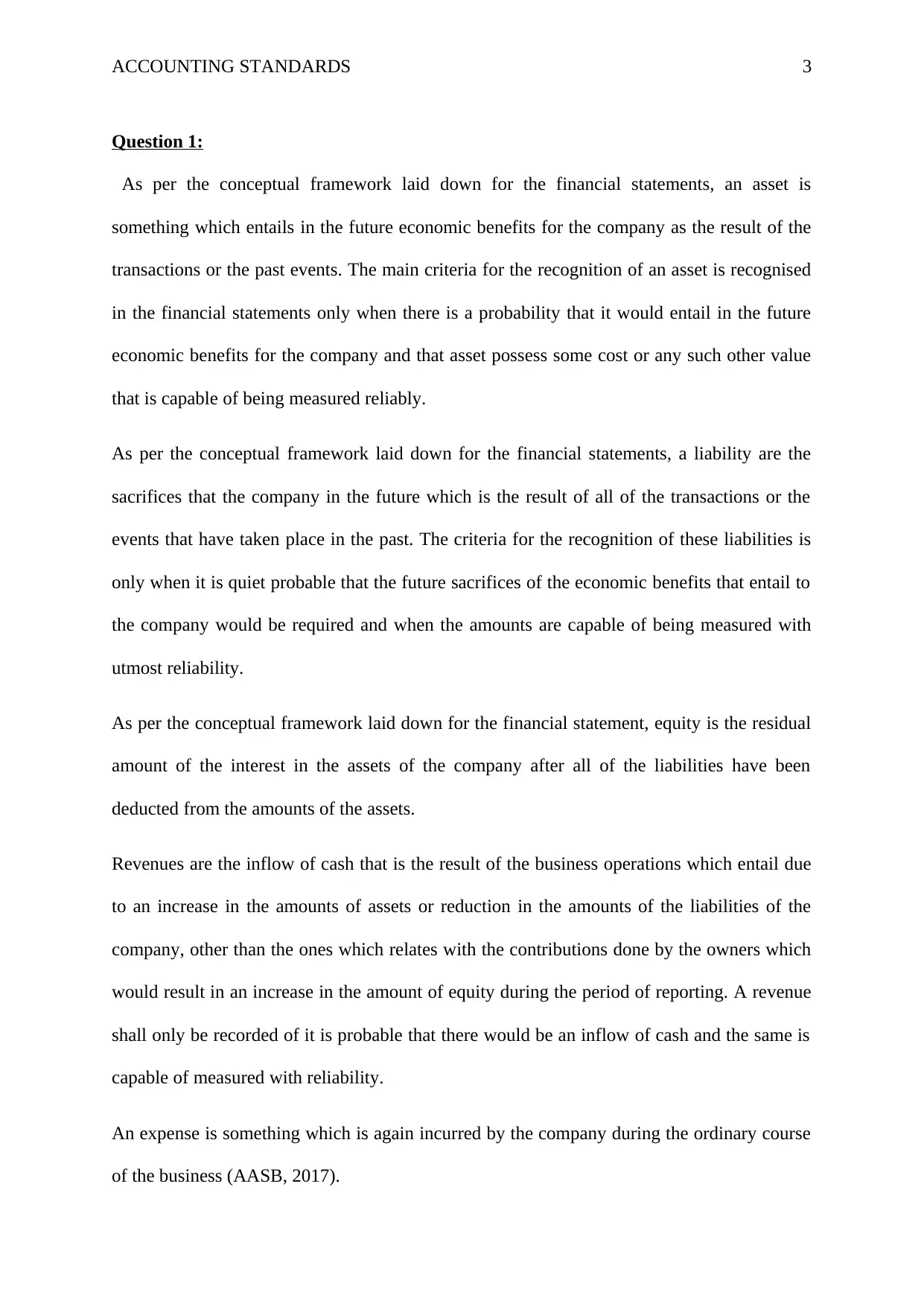
ACCOUNTING STANDARDS 3
Question 1:
As per the conceptual framework laid down for the financial statements, an asset is
something which entails in the future economic benefits for the company as the result of the
transactions or the past events. The main criteria for the recognition of an asset is recognised
in the financial statements only when there is a probability that it would entail in the future
economic benefits for the company and that asset possess some cost or any such other value
that is capable of being measured reliably.
As per the conceptual framework laid down for the financial statements, a liability are the
sacrifices that the company in the future which is the result of all of the transactions or the
events that have taken place in the past. The criteria for the recognition of these liabilities is
only when it is quiet probable that the future sacrifices of the economic benefits that entail to
the company would be required and when the amounts are capable of being measured with
utmost reliability.
As per the conceptual framework laid down for the financial statement, equity is the residual
amount of the interest in the assets of the company after all of the liabilities have been
deducted from the amounts of the assets.
Revenues are the inflow of cash that is the result of the business operations which entail due
to an increase in the amounts of assets or reduction in the amounts of the liabilities of the
company, other than the ones which relates with the contributions done by the owners which
would result in an increase in the amount of equity during the period of reporting. A revenue
shall only be recorded of it is probable that there would be an inflow of cash and the same is
capable of measured with reliability.
An expense is something which is again incurred by the company during the ordinary course
of the business (AASB, 2017).
Question 1:
As per the conceptual framework laid down for the financial statements, an asset is
something which entails in the future economic benefits for the company as the result of the
transactions or the past events. The main criteria for the recognition of an asset is recognised
in the financial statements only when there is a probability that it would entail in the future
economic benefits for the company and that asset possess some cost or any such other value
that is capable of being measured reliably.
As per the conceptual framework laid down for the financial statements, a liability are the
sacrifices that the company in the future which is the result of all of the transactions or the
events that have taken place in the past. The criteria for the recognition of these liabilities is
only when it is quiet probable that the future sacrifices of the economic benefits that entail to
the company would be required and when the amounts are capable of being measured with
utmost reliability.
As per the conceptual framework laid down for the financial statement, equity is the residual
amount of the interest in the assets of the company after all of the liabilities have been
deducted from the amounts of the assets.
Revenues are the inflow of cash that is the result of the business operations which entail due
to an increase in the amounts of assets or reduction in the amounts of the liabilities of the
company, other than the ones which relates with the contributions done by the owners which
would result in an increase in the amount of equity during the period of reporting. A revenue
shall only be recorded of it is probable that there would be an inflow of cash and the same is
capable of measured with reliability.
An expense is something which is again incurred by the company during the ordinary course
of the business (AASB, 2017).
⊘ This is a preview!⊘
Do you want full access?
Subscribe today to unlock all pages.

Trusted by 1+ million students worldwide
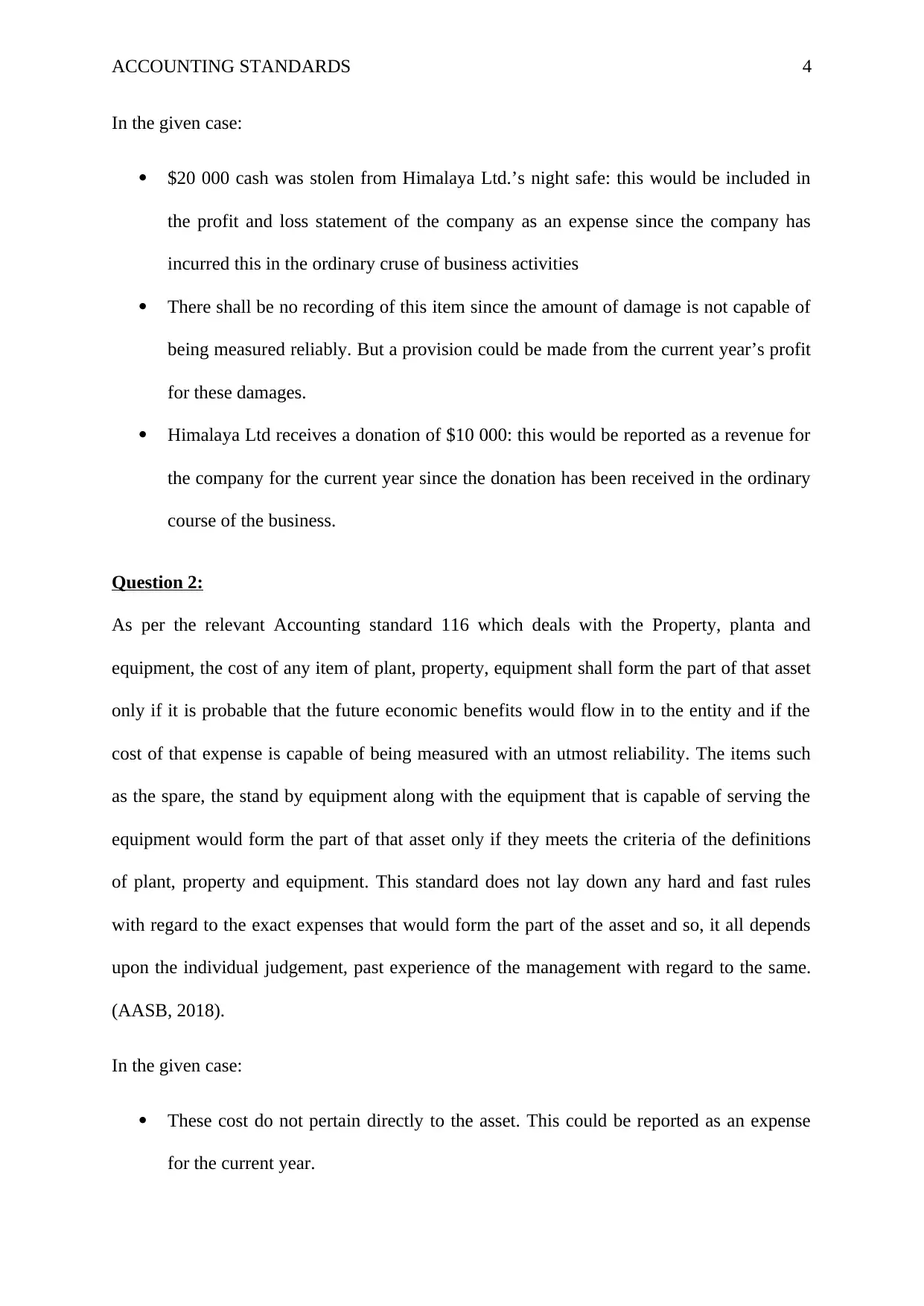
ACCOUNTING STANDARDS 4
In the given case:
$20 000 cash was stolen from Himalaya Ltd.’s night safe: this would be included in
the profit and loss statement of the company as an expense since the company has
incurred this in the ordinary cruse of business activities
There shall be no recording of this item since the amount of damage is not capable of
being measured reliably. But a provision could be made from the current year’s profit
for these damages.
Himalaya Ltd receives a donation of $10 000: this would be reported as a revenue for
the company for the current year since the donation has been received in the ordinary
course of the business.
Question 2:
As per the relevant Accounting standard 116 which deals with the Property, planta and
equipment, the cost of any item of plant, property, equipment shall form the part of that asset
only if it is probable that the future economic benefits would flow in to the entity and if the
cost of that expense is capable of being measured with an utmost reliability. The items such
as the spare, the stand by equipment along with the equipment that is capable of serving the
equipment would form the part of that asset only if they meets the criteria of the definitions
of plant, property and equipment. This standard does not lay down any hard and fast rules
with regard to the exact expenses that would form the part of the asset and so, it all depends
upon the individual judgement, past experience of the management with regard to the same.
(AASB, 2018).
In the given case:
These cost do not pertain directly to the asset. This could be reported as an expense
for the current year.
In the given case:
$20 000 cash was stolen from Himalaya Ltd.’s night safe: this would be included in
the profit and loss statement of the company as an expense since the company has
incurred this in the ordinary cruse of business activities
There shall be no recording of this item since the amount of damage is not capable of
being measured reliably. But a provision could be made from the current year’s profit
for these damages.
Himalaya Ltd receives a donation of $10 000: this would be reported as a revenue for
the company for the current year since the donation has been received in the ordinary
course of the business.
Question 2:
As per the relevant Accounting standard 116 which deals with the Property, planta and
equipment, the cost of any item of plant, property, equipment shall form the part of that asset
only if it is probable that the future economic benefits would flow in to the entity and if the
cost of that expense is capable of being measured with an utmost reliability. The items such
as the spare, the stand by equipment along with the equipment that is capable of serving the
equipment would form the part of that asset only if they meets the criteria of the definitions
of plant, property and equipment. This standard does not lay down any hard and fast rules
with regard to the exact expenses that would form the part of the asset and so, it all depends
upon the individual judgement, past experience of the management with regard to the same.
(AASB, 2018).
In the given case:
These cost do not pertain directly to the asset. This could be reported as an expense
for the current year.
Paraphrase This Document
Need a fresh take? Get an instant paraphrase of this document with our AI Paraphraser
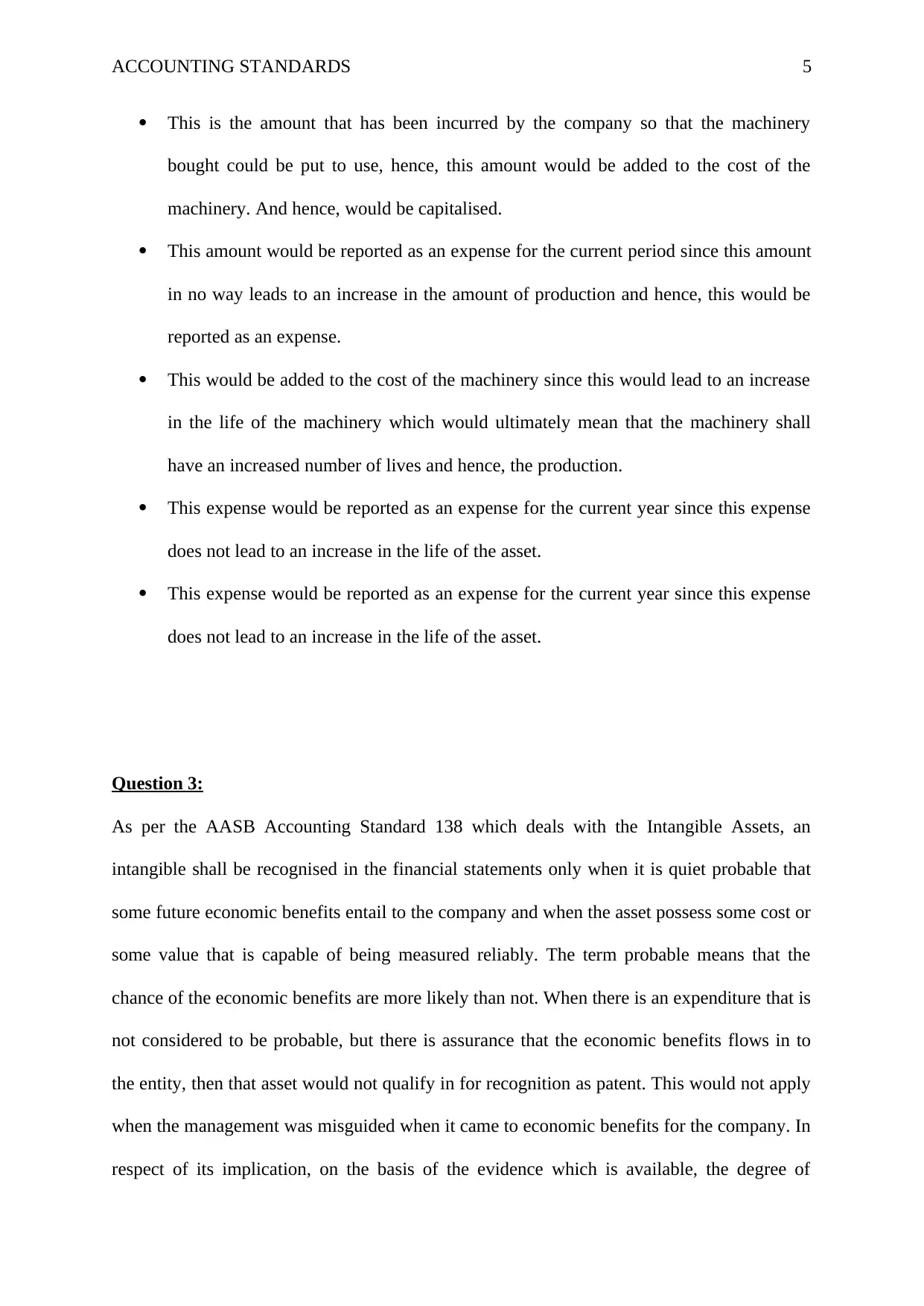
ACCOUNTING STANDARDS 5
This is the amount that has been incurred by the company so that the machinery
bought could be put to use, hence, this amount would be added to the cost of the
machinery. And hence, would be capitalised.
This amount would be reported as an expense for the current period since this amount
in no way leads to an increase in the amount of production and hence, this would be
reported as an expense.
This would be added to the cost of the machinery since this would lead to an increase
in the life of the machinery which would ultimately mean that the machinery shall
have an increased number of lives and hence, the production.
This expense would be reported as an expense for the current year since this expense
does not lead to an increase in the life of the asset.
This expense would be reported as an expense for the current year since this expense
does not lead to an increase in the life of the asset.
Question 3:
As per the AASB Accounting Standard 138 which deals with the Intangible Assets, an
intangible shall be recognised in the financial statements only when it is quiet probable that
some future economic benefits entail to the company and when the asset possess some cost or
some value that is capable of being measured reliably. The term probable means that the
chance of the economic benefits are more likely than not. When there is an expenditure that is
not considered to be probable, but there is assurance that the economic benefits flows in to
the entity, then that asset would not qualify in for recognition as patent. This would not apply
when the management was misguided when it came to economic benefits for the company. In
respect of its implication, on the basis of the evidence which is available, the degree of
This is the amount that has been incurred by the company so that the machinery
bought could be put to use, hence, this amount would be added to the cost of the
machinery. And hence, would be capitalised.
This amount would be reported as an expense for the current period since this amount
in no way leads to an increase in the amount of production and hence, this would be
reported as an expense.
This would be added to the cost of the machinery since this would lead to an increase
in the life of the machinery which would ultimately mean that the machinery shall
have an increased number of lives and hence, the production.
This expense would be reported as an expense for the current year since this expense
does not lead to an increase in the life of the asset.
This expense would be reported as an expense for the current year since this expense
does not lead to an increase in the life of the asset.
Question 3:
As per the AASB Accounting Standard 138 which deals with the Intangible Assets, an
intangible shall be recognised in the financial statements only when it is quiet probable that
some future economic benefits entail to the company and when the asset possess some cost or
some value that is capable of being measured reliably. The term probable means that the
chance of the economic benefits are more likely than not. When there is an expenditure that is
not considered to be probable, but there is assurance that the economic benefits flows in to
the entity, then that asset would not qualify in for recognition as patent. This would not apply
when the management was misguided when it came to economic benefits for the company. In
respect of its implication, on the basis of the evidence which is available, the degree of
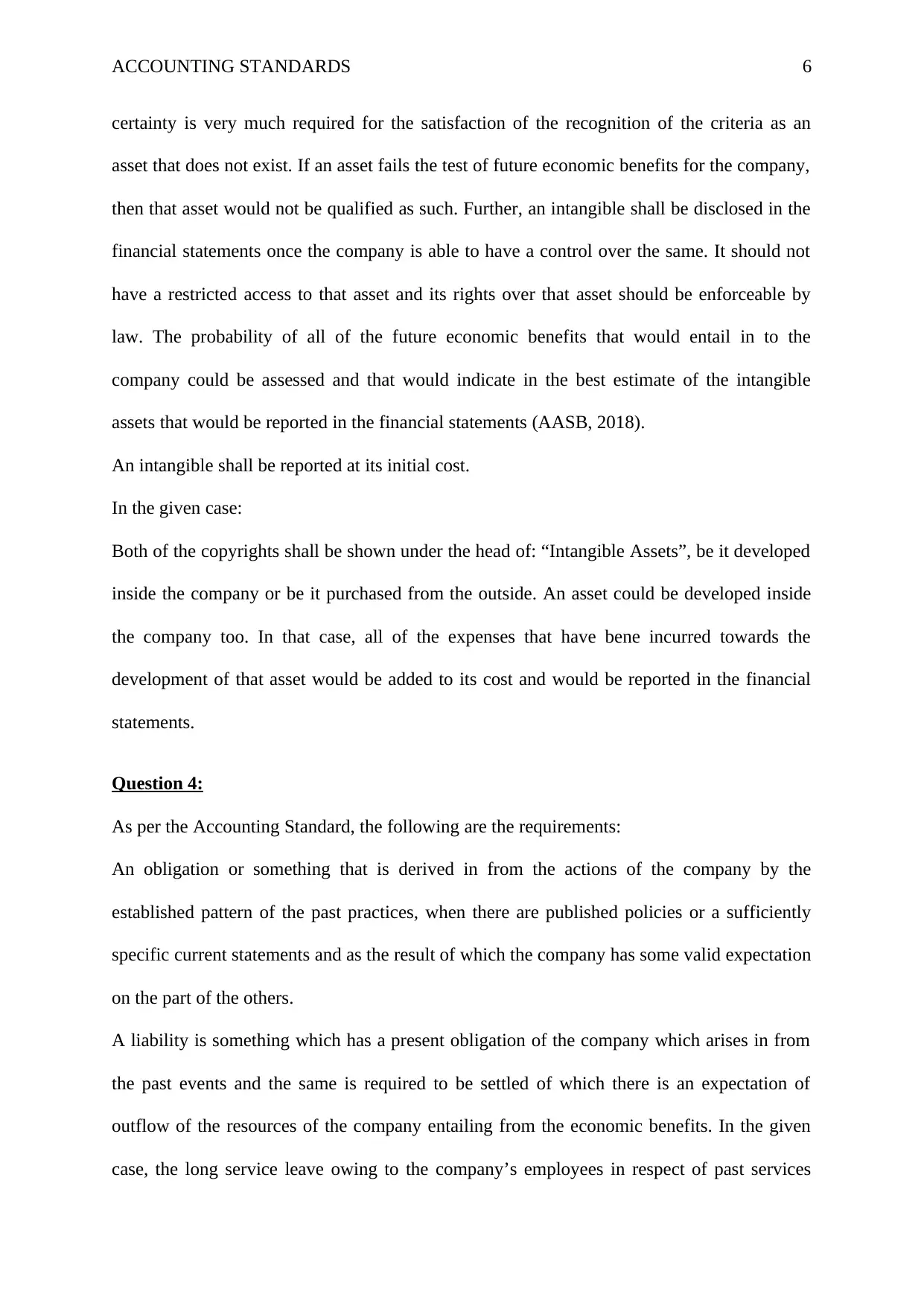
ACCOUNTING STANDARDS 6
certainty is very much required for the satisfaction of the recognition of the criteria as an
asset that does not exist. If an asset fails the test of future economic benefits for the company,
then that asset would not be qualified as such. Further, an intangible shall be disclosed in the
financial statements once the company is able to have a control over the same. It should not
have a restricted access to that asset and its rights over that asset should be enforceable by
law. The probability of all of the future economic benefits that would entail in to the
company could be assessed and that would indicate in the best estimate of the intangible
assets that would be reported in the financial statements (AASB, 2018).
An intangible shall be reported at its initial cost.
In the given case:
Both of the copyrights shall be shown under the head of: “Intangible Assets”, be it developed
inside the company or be it purchased from the outside. An asset could be developed inside
the company too. In that case, all of the expenses that have bene incurred towards the
development of that asset would be added to its cost and would be reported in the financial
statements.
Question 4:
As per the Accounting Standard, the following are the requirements:
An obligation or something that is derived in from the actions of the company by the
established pattern of the past practices, when there are published policies or a sufficiently
specific current statements and as the result of which the company has some valid expectation
on the part of the others.
A liability is something which has a present obligation of the company which arises in from
the past events and the same is required to be settled of which there is an expectation of
outflow of the resources of the company entailing from the economic benefits. In the given
case, the long service leave owing to the company’s employees in respect of past services
certainty is very much required for the satisfaction of the recognition of the criteria as an
asset that does not exist. If an asset fails the test of future economic benefits for the company,
then that asset would not be qualified as such. Further, an intangible shall be disclosed in the
financial statements once the company is able to have a control over the same. It should not
have a restricted access to that asset and its rights over that asset should be enforceable by
law. The probability of all of the future economic benefits that would entail in to the
company could be assessed and that would indicate in the best estimate of the intangible
assets that would be reported in the financial statements (AASB, 2018).
An intangible shall be reported at its initial cost.
In the given case:
Both of the copyrights shall be shown under the head of: “Intangible Assets”, be it developed
inside the company or be it purchased from the outside. An asset could be developed inside
the company too. In that case, all of the expenses that have bene incurred towards the
development of that asset would be added to its cost and would be reported in the financial
statements.
Question 4:
As per the Accounting Standard, the following are the requirements:
An obligation or something that is derived in from the actions of the company by the
established pattern of the past practices, when there are published policies or a sufficiently
specific current statements and as the result of which the company has some valid expectation
on the part of the others.
A liability is something which has a present obligation of the company which arises in from
the past events and the same is required to be settled of which there is an expectation of
outflow of the resources of the company entailing from the economic benefits. In the given
case, the long service leave owing to the company’s employees in respect of past services
⊘ This is a preview!⊘
Do you want full access?
Subscribe today to unlock all pages.

Trusted by 1+ million students worldwide

ACCOUNTING STANDARDS 7
would be termed as a liability since this expenses arises from the pasta activities to the
company and there is an expectation that this would result in a cash flow for the company
(AASB, 2018).
This would not be considered to be a liability till the end of the year 10 since that would
become a liability only once the 10th year is complete. The company does know that this
would be the liability that it will have to pay at some point of time, be it after 10 years. So,
what it could do is that it could keep aside a part of the profit each year for this future
expense in turn liability. This setting aside the amount would be covered under the head of
“Provision”.
would be termed as a liability since this expenses arises from the pasta activities to the
company and there is an expectation that this would result in a cash flow for the company
(AASB, 2018).
This would not be considered to be a liability till the end of the year 10 since that would
become a liability only once the 10th year is complete. The company does know that this
would be the liability that it will have to pay at some point of time, be it after 10 years. So,
what it could do is that it could keep aside a part of the profit each year for this future
expense in turn liability. This setting aside the amount would be covered under the head of
“Provision”.
Paraphrase This Document
Need a fresh take? Get an instant paraphrase of this document with our AI Paraphraser
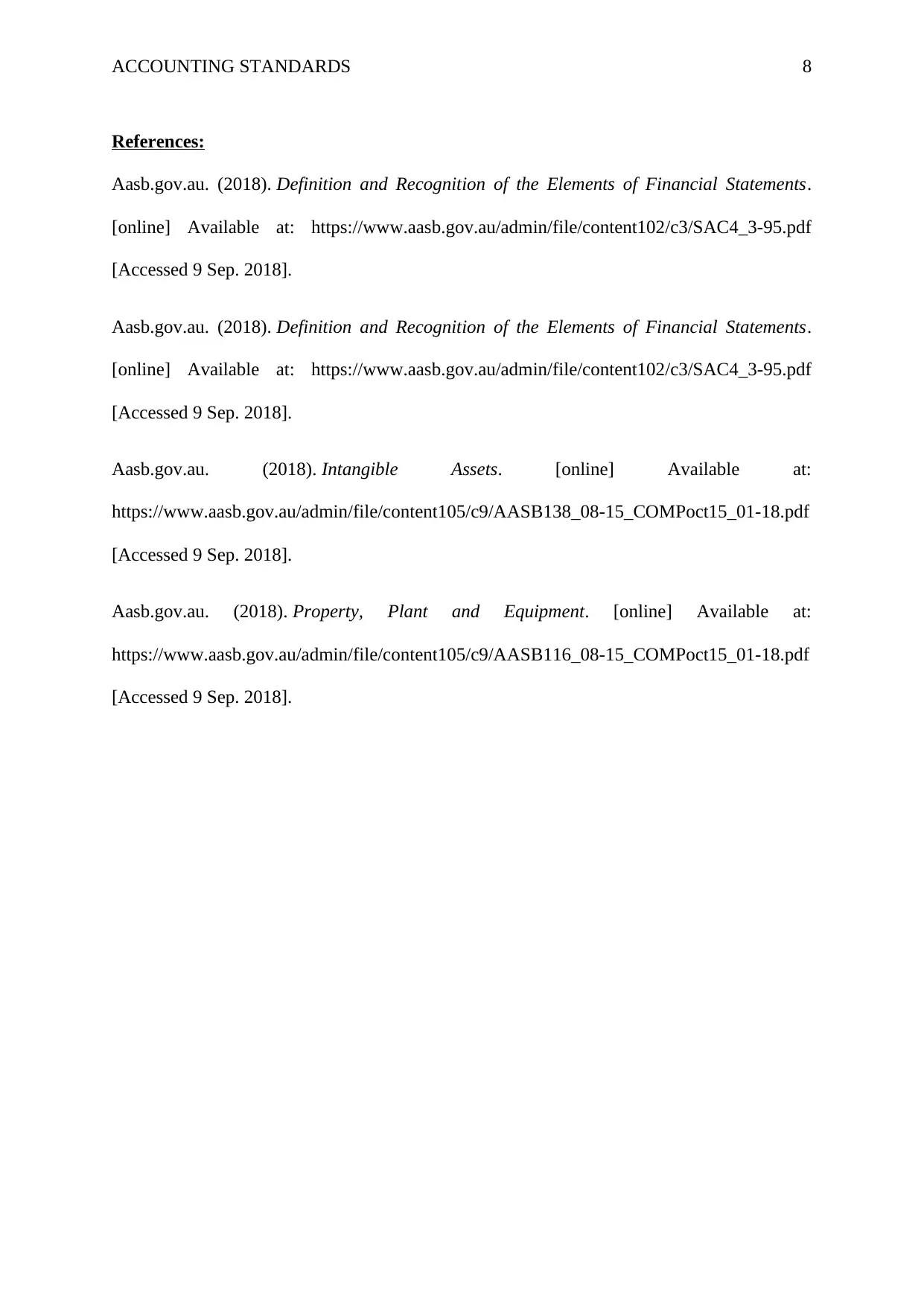
ACCOUNTING STANDARDS 8
References:
Aasb.gov.au. (2018). Definition and Recognition of the Elements of Financial Statements.
[online] Available at: https://www.aasb.gov.au/admin/file/content102/c3/SAC4_3-95.pdf
[Accessed 9 Sep. 2018].
Aasb.gov.au. (2018). Definition and Recognition of the Elements of Financial Statements.
[online] Available at: https://www.aasb.gov.au/admin/file/content102/c3/SAC4_3-95.pdf
[Accessed 9 Sep. 2018].
Aasb.gov.au. (2018). Intangible Assets. [online] Available at:
https://www.aasb.gov.au/admin/file/content105/c9/AASB138_08-15_COMPoct15_01-18.pdf
[Accessed 9 Sep. 2018].
Aasb.gov.au. (2018). Property, Plant and Equipment. [online] Available at:
https://www.aasb.gov.au/admin/file/content105/c9/AASB116_08-15_COMPoct15_01-18.pdf
[Accessed 9 Sep. 2018].
References:
Aasb.gov.au. (2018). Definition and Recognition of the Elements of Financial Statements.
[online] Available at: https://www.aasb.gov.au/admin/file/content102/c3/SAC4_3-95.pdf
[Accessed 9 Sep. 2018].
Aasb.gov.au. (2018). Definition and Recognition of the Elements of Financial Statements.
[online] Available at: https://www.aasb.gov.au/admin/file/content102/c3/SAC4_3-95.pdf
[Accessed 9 Sep. 2018].
Aasb.gov.au. (2018). Intangible Assets. [online] Available at:
https://www.aasb.gov.au/admin/file/content105/c9/AASB138_08-15_COMPoct15_01-18.pdf
[Accessed 9 Sep. 2018].
Aasb.gov.au. (2018). Property, Plant and Equipment. [online] Available at:
https://www.aasb.gov.au/admin/file/content105/c9/AASB116_08-15_COMPoct15_01-18.pdf
[Accessed 9 Sep. 2018].
1 out of 8
Related Documents
Your All-in-One AI-Powered Toolkit for Academic Success.
+13062052269
info@desklib.com
Available 24*7 on WhatsApp / Email
![[object Object]](/_next/static/media/star-bottom.7253800d.svg)
Unlock your academic potential
Copyright © 2020–2025 A2Z Services. All Rights Reserved. Developed and managed by ZUCOL.





